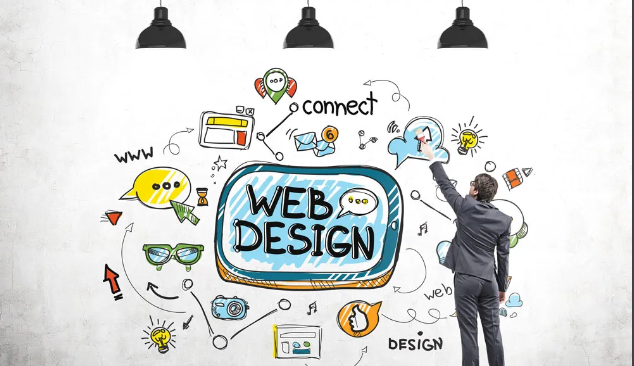The Art and Science of Web Design: Crafting the Perfect User Experience

In today’s digital age, a well-crafted website is crucial for any business or individual aiming to establish a strong online presence. Web design has evolved into a sophisticated discipline that blends creativity with technical expertise to create websites that are not only visually appealing but also highly functional. As the internet continues to expand and user expectations grow, the role of web design in shaping user experiences has never been more important. In this blog post, we’ll explore the key elements of web design, its significance in the digital landscape, and the best practices to follow when creating a website that stands out.
The Importance of Web Design in the Digital Era
The first impression a user has of your brand is often through your website. A poorly designed website can drive potential customers away, while a well-designed site can capture their attention and convert them into loyal customers. Web design goes beyond just aesthetics; it encompasses the layout, functionality, and overall user experience (UX) that contribute to a site’s effectiveness.
In the digital era, where competition is fierce, web design plays a pivotal role in differentiating your brand from the rest. A website that is easy to navigate, visually appealing, and optimized for performance can significantly impact your business’s success. A strong web design can lead to higher engagement rates, improved customer satisfaction, and increased conversion rates.
Core Elements of Web Design
To understand the significance of web design, it’s essential to break down its core elements:
Layout and Structure
The layout of a website is the foundation of its design. A well-structured layout ensures that content is organized in a way that is easy to understand and navigate. The structure of the site should guide users naturally through the content, making it easy for them to find what they’re looking for. Web design involves creating a balanced layout that combines text, images, and other multimedia elements to create a cohesive user experience.
Visual Design
Visual design is the most immediately noticeable aspect of web design. It involves the use of colour schemes, typography, imagery, and other visual elements to create an aesthetically pleasing website. The visual design should align with the brand’s identity and convey the desired message to the audience. A consistent and visually appealing design can enhance the user’s perception of the brand and create a memorable experience.
User Experience (UX) Design
User experience is at the heart of effective web design. UX design focuses on creating a seamless and intuitive experience for users as they interact with the website. This includes ensuring that the site is easy to navigate, the content is accessible, and the overall experience is enjoyable. Good UX design can lead to higher user engagement and satisfaction, ultimately driving business success.
Responsive Design
With the increasing use of mobile devices to access the internet, responsive design has become a crucial aspect of web design. A responsive website adapts to different screen sizes and resolutions, providing a consistent experience across all devices. This ensures that users have a positive experience whether they are accessing the site on a desktop, tablet, or smartphone.
Performance Optimization
Website performance is a critical factor in web design. A slow-loading website can frustrate users and lead to higher bounce rates. Performance optimization involves optimizing images, minimizing code, and implementing caching techniques to ensure that the website loads quickly and efficiently. A well-optimized site provides a smoother experience for users and can positively impact search engine rankings.
The Role of Web Design in SEO
Search engine optimization (SEO) is closely tied to web design. A well-designed website not only enhances user experience but also improves search engine rankings. Search engines like Google prioritize websites that offer a good user experience, are mobile-friendly, and load quickly. Here are some ways in which web design impacts SEO:
Mobile-Friendliness
Google has adopted a mobile-first indexing approach, meaning that the mobile version of your website is prioritized in search rankings. Responsive web design ensures that your site is mobile-friendly, which is essential for achieving high search engine rankings.
Site Speed
As mentioned earlier, site speed is a critical factor in both user experience and SEO. A fast-loading website is more likely to rank higher in search engine results pages (SERPs). Web design practices that focus on performance optimization can help improve site speed and, consequently, search rankings.
User Experience
Search engines take user experience into account when ranking websites. A well-designed website that offers easy navigation, clear calls-to-action, and a seamless user experience is more likely to rank higher. Web design that prioritizes UX can lead to lower bounce rates and longer time spent on the site, both of which are positive signals for search engines.
Structured Data and Metadata
Web design also involves the implementation of structured data and metadata, which help search engines understand the content of your site. Properly structured data can enhance your website’s visibility in search results, leading to higher click-through rates.
Best Practices for Effective Web Design
Creating an effective web design requires a combination of creativity, technical knowledge, and an understanding of user behaviour. Here are some best practices to follow when designing a website:
Prioritize User-Centered Design
User-centered design is a design philosophy that places the user at the centre of the design process. This involves understanding the needs, preferences, and behaviours of your target audience and designing a website that caters to those needs. Web design that prioritizes the user experience will result in higher engagement and satisfaction.
Keep it Simple and Intuitive
Simplicity is key in web design. A cluttered and complex design can overwhelm users and make it difficult for them to navigate the site. Aim for a clean, minimalist design that is easy to understand and use. Intuitive navigation, clear calls-to-action, and straightforward content are essential elements of a simple and effective design.
Focus on Accessibility
Accessibility is an important aspect of web design that ensures your website is usable by everyone, including people with disabilities. Implementing accessibility features such as alt text for images, keyboard navigation, and screen reader compatibility can make your website more inclusive and improve the overall user experience.
Optimize for Speed
As discussed earlier, site speed is crucial for both user experience and SEO. Web design practices that focus on optimizing images, minimizing code, and implementing caching techniques can help improve site speed and ensure a smooth user experience.
Stay Consistent with Branding
Consistency is important in web design, especially when it comes to branding. Your website should reflect your brand’s identity, with consistent use of colours, typography, and imagery. A cohesive design that aligns with your brand’s values and messaging can create a stronger connection with your audience.
The Future of Web Design: Emerging Trends and Technologies
Web design is a constantly evolving field, with new trends and technologies emerging regularly. Staying up-to-date with these developments is essential for creating modern, effective websites. Here are some trends and technologies that are shaping the future of web design:
Artificial Intelligence and Machine Learning
Artificial intelligence (AI) and machine learning are making their way into web design, offering new possibilities for personalization and user experience. AI-powered tools can analyse user behaviour and preferences to deliver personalized content and recommendations, enhancing the overall experience.
Voice User Interface (VUI)
With the rise of voice-activated devices like smart speakers and virtual assistants, voice user interfaces (VUI) are becoming an important consideration in web design. Designing for voice involves creating a seamless interaction between the user and the website through voice commands, providing a hands-free browsing experience.
Augmented Reality (AR) and Virtual Reality (VR)
Augmented reality (AR) and virtual reality (VR) are transforming the way users interact with websites. These technologies offer immersive experiences that can be used in various industries, from e-commerce to real estate. Incorporating AR and VR into web design can create engaging and interactive experiences that captivate users.
Microinteractions
Microinteractions are small, subtle animations or design elements that provide feedback to the user. These can include hover effects, loading animations, or button transitions. Microinteractions enhance the user experience by making the website feel more responsive and interactive.
Dark Mode
Dark mode is a trend that has gained popularity in recent years. Offering a dark mode option allows users to switch to a darker colour scheme, which can reduce eye strain and save battery life on mobile devices. Incorporating dark mode into web design can enhance the user experience and provide a modern, stylish look.
Conclusion: The Power of Effective Web Design
In conclusion, web design is a multifaceted discipline that plays a critical role in the success of a website. A well-designed website can enhance user experience, improve search engine rankings, and ultimately drive business success. By understanding the core elements of web design and following best practices, you can create a website that stands out in the digital landscape. As technology continues to evolve, staying up-to-date with emerging trends and incorporating them into your web design strategy will ensure that your website remains modern, effective, and engaging.
Whether you’re designing a website for a small business, an e-commerce platform, or a personal blog, investing in high-quality web design is essential for achieving your online goals. Remember, your website is often the first point of contact between you and your audience—make sure it leaves a lasting impression.

Siz de Akdingold ailesine katılın ve geleneksel el işçiliğinin eşsiz güzelliklerini keşfedin.
Akdingold, Geleneksel El İşçiliğinin İncisi
Can you be more specific about the content of your article? After reading it, I still have some doubts. Hope you can help me.
Hi there this is somewhat of off topic but I was wanting to know if blogs use WYSIWYG editors or if you have to
manually code with HTML. I’m starting a blog soon but have
no coding experience so I wanted to get guidance from someone with experience.
Any help would be enormously appreciated!
Your article helped me a lot, is there any more related content? Thanks!
Your article helped me a lot, is there any more related content? Thanks!
I don’t think the title of your article matches the content lol. Just kidding, mainly because I had some doubts after reading the article.
Can you be more specific about the content of your article? After reading it, I still have some doubts. Hope you can help me.
Your article helped me a lot, is there any more related content? Thanks!
Thanks for sharing. I read many of your blog posts, cool, your blog is very good.
Can you be more specific about the content of your article? After reading it, I still have some doubts. Hope you can help me.